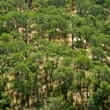Background
- Chaparral is a shrub found in the desert regions of southwestern United States and Mexico. It was used by Native American populations for indications including chicken pox (varicella), colds, diarrhea, menstrual cramps, pain, rheumatic diseases, skin disorders, snake bites, and as an emetic. Chaparral tea was also used for purported effects of removing lysergic acid diethylamide (LSD) residue and thereby preventing recurrent hallucinations. Chaparral leaves have also been used externally for bruises, scratches, wounds, and hair growth.
- The chaparral component nordihydroguaiaretic acid (NDGA) has been evaluated as a treatment for cancer but, due to risk of toxicity, it is considered unsafe and not recommended for use.
References
Natural Standard developed the above evidence-based information based on a thorough systematic review of the available scientific articles. For comprehensive information about alternative and complementary therapies on the professional level, go to . Selected references are listed below.
- Anonymous. From the Centers for Disease Control and Prevention. Chaparral-induced toxic hepatitis: California and Texas, 1992. JAMA 1992;Dec 16, 268(23):3295, 3298.
View Abstract - Anonymous. Chaparral-induced toxic hepatitis: California and Texas, 1992. MMWR Morb Mortal Wkly Rep 1992;Oct 30, 41(43):812-814.
View Abstract - Fleiss PM. Chaparral and liver toxicity. JAMA 9-20-1995;274(11):871-872.
View Abstract - Gimeno MF, Shattner MA, Borda E, et al. Lipoxygenase inhibitors alter aggregation and adhesiveness of human blood platelets from aspirin-treated patients. Prostaglandins Leukot Med 1983;11(1):109-119.
View Abstract - Gordon DW, Rosenthal G, Hart J, et al. Chaparral ingestion: the broadening spectrum of liver injury caused by herbal medications. JAMA 1995;Feb 8, 273(6):489-490.
View Abstract - Heron S, Yarnell E. The safety of low-dose Larrea tridentata (DC) Coville (creosote bush or chaparral): a retrospective clinical study. J Altern Complement Med 2001;7(2):175-185.
View Abstract - Ippen H. Chaparral and liver toxicity. JAMA 1995;Sep 20, 274(11):871. Author reply, 871-872.
View Abstract - Kassler WJ, Blanc P, Greenblatt R. The use of medicinal herbs by human immunodeficiency virus-infected patients. Arch Intern Med 1991;151(11):2281-2288.
View Abstract - Kauma H, Koskela R, Mäkisalo H, et al. Toxic acute hepatitis and hepatic fibrosis after consumption of chaparral tablets. Scand J Gastroenterol. 2004;39(11):1168-71.
View Abstract - Obermeyer WR, Musser SM, Betz JM, et al. Chemical studies of phytoestrogens and related compounds in dietary supplements: flax and chaparral. Proc Soc Exp Biol Med 1995;208(1):6-12.
View Abstract - Smart CR, Hogle HH, Vogel H, et al. Clinical experience with nordihydroguaiaretic acid--"chaparrel tea" in the treatment of cancer. Rocky Mt Med J 1970;67(11):39-43.
View Abstract - Smith AY, Feddersen RM, Gardner KD Jr, et al. Cystic renal cell carcinoma and acquired renal cystic disease associated with consumption of chaparral tea: a case report. J Urol. 1994;152(6 Pt 1):2089-2091.
View Abstract - Stickel F, Schuppan D. Herbal medicine in the treatment of liver diseases. Dig Liver Dis. 2007;39(4):293-304.
View Abstract - Stickel F, Egerer G, Seitz HK. Hepatotoxicity of botanicals. Public Health Nutr 2000;Jun, 3(2):113-124. Comment in: Public Health Nutr 2000;Jun, 3(2):111.
View Abstract - Woolf GM, Petrovic LM, Rojter SE, et al. Acute hepatitis associated with the Chinese herbal product jin bu huan. Ann Intern Med 11-15-1994;121(10):729-735.
View Abstract







